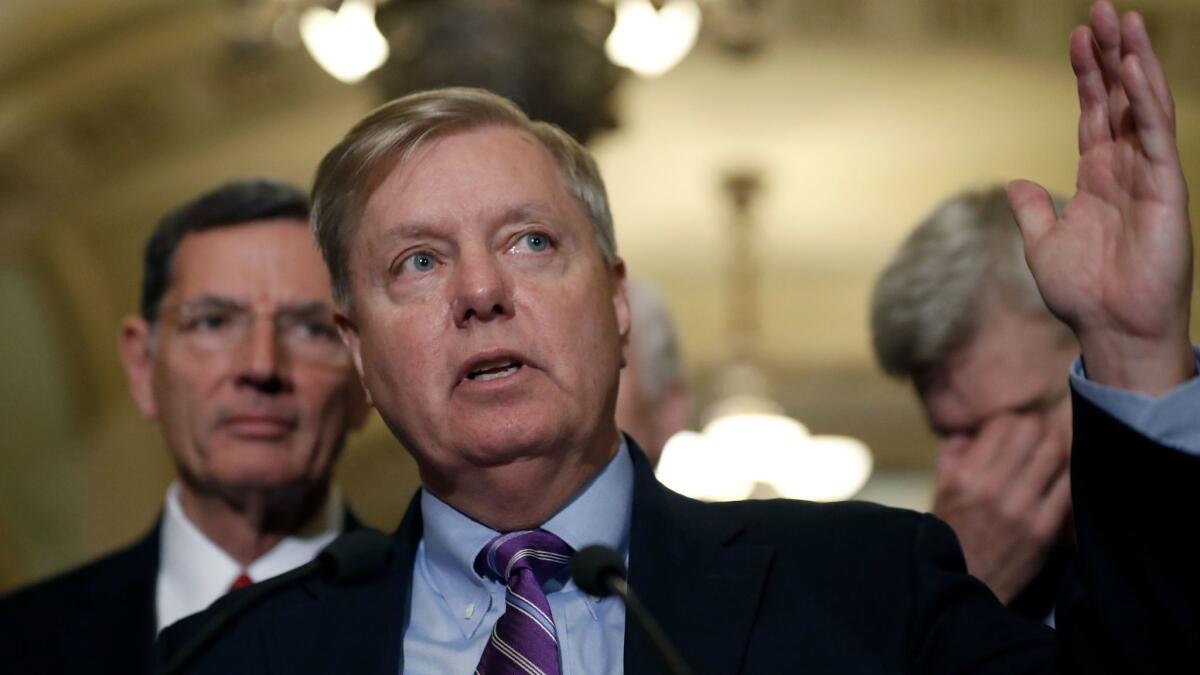Column: The disastrous impact of the GOP’s Obamacare repeal plan, in three devastating charts

The healthcare consulting firm Avalere on Wednesday released the latest in a series of independent analyses of Senate Republicans’ new effort to repeal the Affordable Care Act. The findings are beyond ugly. They show devastating cuts in healthcare funding for adults, children and the disabled — in effect, almost every population category in the U.S. other than seniors enrolled in Medicare.
Since Senate Republicans appear determined to jam through this repeal measure by Sept. 30 without a relevant scoring by the Congressional Budget Office, outside analyses by experts such as Avalere’s are particularly important. The firm’s analysis joins a study by the progressive Center on Budget and Policy Priorities, number-crunching by David Anderson of Duke University, and others.
The studies are unanimous on the directional flow of federal healthcare funds under the bill: away from states that have embraced the Affordable Care Act, including by expanding Medicaid, and toward those that have shunned it. But all also show deep cuts in total federal funding, especially after 2026. Charts from Avalere putting the damage in graphical form are below.
“Medicaid expansion states and states that have enrolled a high number of people in insurance affordability programs would be most adversely impacted,” concludes Elizabeth Carpenter, a senior vice president at Avalere Health.
That may be why a bipartisan group of 10 governors wrote Tuesday to Senate Majority Leader Mitch McConnell (R-Ky.) to “urge you not to consider Graham-Cassidy-Heller-Johnson” and instead encourage the bipartisan talks on reforming the Affordable Care Act that had been led by Sens. Lamar Alexander (R-Tenn.) and Susan Collins (D-Maine). Alexander ended those talks this week as the GOP bill gained steam. The repeal bill is named for its chief sponsors, all Republicans: Sens. Bill Cassidy of Louisiana, Lindsey Graham of South Carolina, Dean Heller of Nevada and Ron Johnson of Wisconsin.
Medicaid expansion states and states that have enrolled a high number of people in insurance affordability programs would be most adversely impacted.
— Elizabeth Carpenter, Avalere
Two of the four governors of their states signed the letter to McConnell — Republican Brian Sandoval of Nevada and Democrat John Bel Edwards of Louisiana. Republican Gov. Henry McMaster of South Carolina didn’t sign the letter, but so far has refused to commit himself to supporting the repeal bill. Wisconsin’s Republican Gov. Scott Walker supports the bill.
The CBO earlier this week informed Senate leaders that it would be able to provide only a preliminary assessment in time for a vote. Its analysis won’t cover “effects on the deficit, health insurance coverage, or premiums,” the CBO said — all crucial considerations in enacting a measure that will affect the health coverage of millions of Americans.
As we’ve reported previously, the repeal bill would lump the funding for the ACA’s Medicaid expansion together with the federal subsidies being paid for individual coverage via the Obamacare exchanges, and redistribute it to states as block grants according to a complex formula. By 2026, the block grants would come to $215 billion less than would be paid out nationwide, according to Avalere; CBPP places the shortfall at $239 billion. After 2026, all the funding would disappear. By 2036, the shortfall compared to what’s expected under the Affordable Care Act and current Medicaid funding standards would total $4.1 trillion.
That’s money that states would have to make up themselves to maintain current or expected levels of healthcare. Otherwise, dealing with population changes and exigent needs would force them to cut way back on enrollment and benefits in public programs or to cannibalize funding for other public programs.
The following charts illustrate the resulting devastation. In the first phase, covering the period through 2026, states that have done most for their residents by embracing the Affordable Care Act’s Medicaid expansion and other features would get hammered. California would lost $129 billion in funding, New York $71 billion, Massachusetts $14 billion. States that left their residents to the mercies of fate by refusing Medicaid expansion and interfering with ACA outreach would get more funding — Texas an infusion of $24 billion, for instance.
From now through 2036, however, including the period after the elimination of all such federal funding, every state would see a loss in federal funding, though pro-ACA states would be among the biggest losers.
The funding cuts would be harmful to residents across the board, Avalere found, with only minimal help for the most vulnerable populations. For all adults, funding would be cut by 37% through 2036. For children, it would be 31% and for the disabled, 15%.
Cassidy and Graham are pitching their repeal bill as an offer of “flexibility” for states, the shibboleth being that states have a better idea of how to spend healthcare dollars than the federal government since governors and legislators are supposedly closer to the people. The Avalere study makes short work of that claim.
“States would have broad flexibility to shape their markets,” the firm says, “but would have less funding to subsidize coverage for low- and middle-income individuals.”
Beyond that, the “flexibility” could be poisonous for many residents, as the repeal bill would allow states to seek waivers of the ACA’s essential minimal benefits, which require that all health plans cover maternity, mental health services, prescriptions and hospitalization, among other services. States could also seek waivers of the ACA’s protections for people with preexisting medical conditions. This heralds a charge back to the pre-ACA past, when insurers could keep such patients out of their insurance pool by charging them unaffordable premiums.
The only question that remains is why any senator would vote for this bill. The only answer offered by its sponsors is that the deadline for passing it with only 50 votes is Sept. 30; after that it would require 60, which would enable Democrats to bury it, as they should.
Keep up to date with Michael Hiltzik. Follow @hiltzikm on Twitter, see his Facebook page, or email [email protected].
Return to Michael Hiltzik’s blog.
UPDATES:
8:24 a.m., Sept. 21: This post has been updated to correct the state represented by Sen. Ron Johnson.
More to Read
Inside the business of entertainment
The Wide Shot brings you news, analysis and insights on everything from streaming wars to production — and what it all means for the future.
You may occasionally receive promotional content from the Los Angeles Times.











